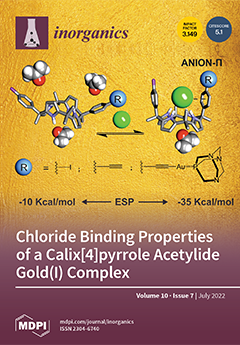The global demand on adipic usage in the production of plasticizers and synthetic polyamide is increasing. In line with the search for an efficient and energy-conserving way to isolate adipic acid (AA) in good yields, this paper introduces the oxidization of cyclohexanone utilizing two new coordination compounds, [Mn(2,6-pydc)
2](imi) (
1) and [Co(H
2pza)
2(H
2O)
2(NO
3)].NO
3 (
2), as catalysts. Compounds
1 and
2 were synthesized by room temperature and refluxing methods, and characterized by spectral analyses (IR and UV-Vis.), SEM, BET, TGA, elemental, and X-ray crystallography. The single crystal structure of compound
1 revealed that pyridinedicarboxylate (2,6-pydc) and imidazole (imi) moieties were coordinated to the Mn(II) atom through imine nitrogen and deprotonated oxygen atoms, to form an undistorted octahedral coordination geometry with the N
2O
4 donor set. The axial and equatorial planes containing O2, O4, O5, and O7 atoms were from two adjacent 2,6-pydc ligands which formed the unidendate donor ligand; imi, on the other hand, acted as a bidendate donor ligand. For compound
2, the Co(II) atom was being coordinated by two pyrazinamide (H
2pza) moieties, which acted as an unidendate donor ligand; two water molecules occupying the axial position, and one nitrate molecule occupying the apical position, were within the coordination sphere; a nitrate molecule was disordered outside the coordination sphere. The distance, 4.658 Å, between the Co1 atom and the N8 atom of the uncoordinated nitrate molecule, was within the range reported elsewhere. Cyclohexanone peroxidation experiments revealed that compound
1 exhibited unique catalytic performance by giving a 72.8% yield in adipic acid, in comparison to the 71.3% yield obtained with compound
2. The yields in AA were maintained by way of recyclability evaluation. The reaction kinetics of compound
2 gave less activation energy, E
a 2938 J mol
−1, while the thermodynamic parameters indicated that the chemical reactivity of cyclohexanone on the active surfaces of compounds
1 and
2 was via monolayer physisorption.
Full article





